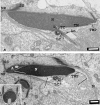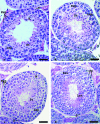Unique features of spermiogenesis in the Musky Rat-kangaroo: reflection of a basal lineage or a distinct fertilization process?
- PMID: 18304206
- PMCID: PMC2408993
- DOI: 10.1111/j.1469-7580.2008.00861.x
Unique features of spermiogenesis in the Musky Rat-kangaroo: reflection of a basal lineage or a distinct fertilization process?
Abstract
Previous research has found the mature spermatozoon of the Musky Rat-kangaroo to share many characteristics with other macopodoids, some phalangeroids and even the dasyurids. While there have been several studies published on the ultrastructure of the mature marsupial spermatozoon, there are only a few detailed studies on marsupial spermatogenesis. Furthermore, there have been no studies undertaken which combine the staging of the epithelial cell cycle with transmission electron microscopy to describe the ultrastructural changes in the developing spermatozoon during these stages. Such studies have the potential to be used in determining the required time taken for certain components of the spermatozoa to develop. During this study, eight stages of the seminiferous epithelium were observed and the ultrastructure of spermatogenesis was divided into nine phases. Maturational processes in the epididymides are also described. Among the features reported are: the formation of a unique acrosomal granule different from those reported in any other marsupial, the absence of contraction of the nuclear ring, a conspicuous acrosomal compaction process despite the almost 100% coverage of the dorsal nuclear surface and the retention of late spermatids within the seminiferous tubules until the early spermatids have developed to the nuclear protrusion phase.
Figures














Similar articles
-
Spermiogenesis in birds.Spermatogenesis. 2014 Oct 30;4(3):e959392. doi: 10.4161/21565554.2014.959392. eCollection 2014 Sep-Dec. Spermatogenesis. 2014. PMID: 26413401 Free PMC article. Review.
-
Spermatogenesis and ultrastructure of a peculiar acrosomal formation in the musk shrew, Suncus murinus.J Anat. 1994 Dec;185 ( Pt 3)(Pt 3):503-9. J Anat. 1994. PMID: 7649786 Free PMC article.
-
Sperm ultrastructure and spermatogenesis in the lizard, Tropidurus itambere.Biocell. 2003 Dec;27(3):353-62. Biocell. 2003. PMID: 15002752
-
Structural modification of the hamster sperm acrosome during posttesticular development in the epididymis.Microsc Res Tech. 2003 May 1;61(1):46-55. doi: 10.1002/jemt.10316. Microsc Res Tech. 2003. PMID: 12672122
-
Organization and modifications of sperm acrosomal molecules during spermatogenesis and epididymal maturation.Microsc Res Tech. 2003 May 1;61(1):39-45. doi: 10.1002/jemt.10315. Microsc Res Tech. 2003. PMID: 12672121 Review.
Cited by
-
Enrichment of spermatogonial stem cells and staging of the testis cycle in a dasyurid marsupial, the fat-tailed dunnart.Stem Cells. 2025 Mar 10;43(3):sxaf007. doi: 10.1093/stmcls/sxaf007. Stem Cells. 2025. PMID: 39943734 Free PMC article.
-
Stages and duration of the seminiferous epithelium cycle in the bat Sturnira lilium.J Anat. 2013 Mar;222(3):372-9. doi: 10.1111/joa.12016. Epub 2013 Jan 10. J Anat. 2013. PMID: 23305159 Free PMC article.
-
Spermiogenesis in birds.Spermatogenesis. 2014 Oct 30;4(3):e959392. doi: 10.4161/21565554.2014.959392. eCollection 2014 Sep-Dec. Spermatogenesis. 2014. PMID: 26413401 Free PMC article. Review.
-
The seminiferous epithelial cycle and microanatomy of the koala (Phascolarctos cinereus) and southern hairy-nosed wombat (Lasiorhinus latifrons) testis.J Anat. 2013 Mar;222(3):380-9. doi: 10.1111/joa.12020. Epub 2013 Jan 1. J Anat. 2013. PMID: 23278248 Free PMC article.
References
-
- Bilaspuri GS, Kaur R. Spermatogenic cells and stages of the seminiferous epithelial cycle in the Indian Gerbil Field Rat. Reprod Fertil Dev. 1994;6:699–704. - PubMed
-
- Ceyhan A, Cincik M, Bedir S, Ustun H, Dagli G, Kalender H. Effects of exposure to new inhalation anesthetics on spermatogenesis and sperm morphology in rabbits. Arch Androl. 2005;51:305–315. - PubMed
-
- Harding HR. Sydney: University of New South Wales; 1977. Reproduction in male marsupials, A critique with additional observations on sperm development and structure. PhD Thesis.
-
- Harding HR. Interrelationships of the families of the diprotodonta – A view based on spermatozoan ultrastructure. In: Archer M, editor. Possums and Opossums: Studies in Evolution. Vol. 1. Sydney: Surrey Beatty & Sons and The Royal Zoological Society of NSW; 1987. pp. 195–216.
-
- Harding HR, Carrick FN, Shorey CD. Spermiogenesis in the Brush-tailed Possum, Trichosurus vulpecula (Marsupialia) Cell Tissue Res. 1976a;171:75–90. - PubMed
MeSH terms
LinkOut - more resources
Full Text Sources

